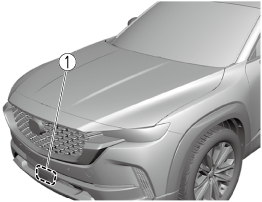

Front Radar Sensor
Your vehicle is equipped with a front radar sensor.

-
Front radar sensor
The following systems also use the front radar sensor.
-
Distance & Speed Alert (DSA)
-
Mazda Radar Cruise Control with Stop & Go function (MRCC with Stop & Go function)
-
Traffic Jam Assist (TJA)
-
Smart Brake Support (SBS) forward drive detection
The front radar sensor functions by detecting the radio waves reflected off a vehicle ahead or an obstruction sent from the radar sensor.
Heed the following precautions to assure correct operation of each system.
-
Do not apply a sticker (including a transparent one) to the front radar sensor cover or replace the front radar sensor cover with a product other than a genuine product.
-
The front radar sensor includes a function for detecting soiling of the radar sensor's front surface and informing the driver, however, depending on the conditions, it may require time to detect or it may not detect plastic shopping bags, ice or snow. If this occurs, the system may not operate correctly, therefore always keep the front radar sensor clean.
-
If “Safety and Driver Support Systems Temporarily Disabled. Front Radar Obscured. Drive Safely” is displayed on the multi-information display of the instrument cluster, clean the area around the front radar sensor.
-
Do not install a grille guard.
-
If the front part of the vehicle has been damaged in a vehicle accident, the position of the front radar sensor may have moved. Stop the system immediately and always have the vehicle inspected at an Authorized Mazda Dealer.
-
Do not use the front bumper to push other vehicles or obstructions such as when pulling out of a parking space. Otherwise, the front radar sensor could be hit and its position deviated.
-
For repairs, replacement or paint work around the front radar sensor, consult an Authorized Mazda Dealer.
-
Always use tires for all wheels that are of the specified size, and the same manufacturer, brand, and tread pattern. In addition, do not use tires with significantly different wear patterns on the same vehicle as the system may not operate normally.
-
If the battery power is weak, the system may not operate correctly.
-
When driving on roads with little traffic and few vehicles ahead or obstructions for the front radar sensor to detect, “Safety and Driver Support Systems Temporarily Disabled. Front Radar Obscured. Drive Safely” may be temporarily displayed, however, this does not indicate a problem.
-
The radar sensors are regulated by the relevant radio wave laws of the country in which the vehicle is driven. If the vehicle is driven abroad, authorization from the country in which the vehicle is driven may be required.
When the vehicle is driven on roads in which there is an elevated road on one side, the front radar sensor function may be restricted temporarily.
When any of the following conditions is met, the front radar sensor may not be able to detect vehicles ahead or obstructions correctly and each system may not operate normally.
-
The rear surface of a vehicle ahead does not reflect radio waves effectively (such as an unloaded trailer, a vehicle with a loading platform covered by a soft top, a vehicle with a hard plastic liftgate, and a round-shaped vehicle).
-
A vehicle ahead has limited areas that can reflect radio waves (such as a low profile vehicle).
-
Under bad weather conditions (rain, fog, and snow).
-
Front visibility is reduced (due to a vehicle ahead casting off water, snow, or sand).
-
Foreign matter (ice, snow, or dirt) is on the surface of the front radar sensor cover.
-
Your vehicle is tilted (such as when heavy luggage is in the luggage compartment or on the rear seat).
-
The vehicle is driven near facilities or objects emitting strong radio waves.
When any of the following conditions is met, the front radar sensor may detect vehicles in the opposite lane or surrounding obstructions, or it may not be able to detect vehicles ahead or obstructions, and each system may not operate normally.
-
The vehicle ahead enters the front radar sensor’s blind spot.
-
The distance to the vehicle ahead is extremely close.
-
The vehicle ahead is being driven in an unstable condition.
-
A vehicle suddenly comes close such as by cutting into your lane.
-
The vehicle is entering or exiting a curve.
-
The vehicle is driven on a continuously curving road.
-
The vehicle is driven on roads with repeated up and downslopes.
-
The vehicle is driven on roads with narrow lanes.
-
The vehicle is driven on poor roads or unpaved roads.


